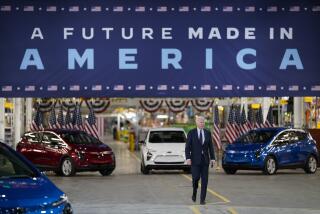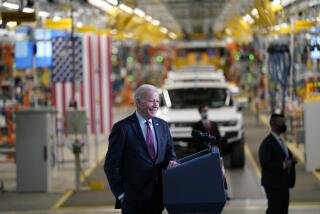Who should be steering?
- Share via
Aday before he was due to accept or reject the restructuring plans submitted by General Motors and Chrysler, President Obama decided instead to throw the beleaguered carmakers another lifeline. Obama gave the companies 30 to 60 more days to prove that they’re headed toward self-sufficiency. If they haven’t succeeded by then, the president warned, Washington’s support will end. No more extensions, no more pump fakes. Honest.
We’d like to believe him, just as we’d like to see GM and Chrysler remodel themselves into sleeker, more competitive companies capable of reversing a decades-long slide in U.S. automakers’ market share. Nevertheless, we’re troubled by the shift in administration policy, which is just the latest in a series of oscillations in Washington’s rescue efforts. And although we shed no tears for Rick Wagoner, the GM chairman and chief executive forced out by Obama on Monday, we wonder how much of its own stamp the administration plans to leave on the automakers.
In fairness, the March 31 deadline wasn’t Obama’s idea. It was set by President Bush, who agreed to give the companies three months -- and $17.4 billion in loans -- to come up with plans for surviving without the government’s help. Obama gave GM a 60-day do-over, while offering Chrysler 30 days to come up with a better plan and sign a partnership agreement with Fiat (a company that did a sweeping restructuring of its own seven years ago).
The problem is that Washington’s so-far empty threats haven’t prodded bondholders, unions and other stakeholders to make the cost-cutting concessions needed to help GM and Chrysler compete. We’ve argued that the best place for the automakers to restructure is in Bankruptcy Court, where recalcitrant interests can be forced to make more sacrifices. The administration can’t exert as much control there, which could prove costly to Obama among union members. But we’re more comfortable letting the companies’ stakeholders decide what the firms should look like in the future, rather than having the administration decide what’s best for them and the car-buying public.






